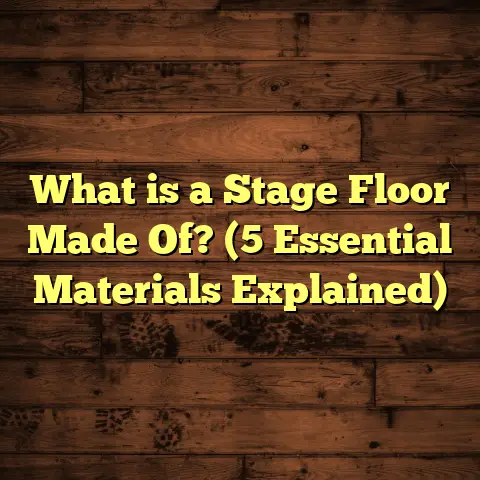What is Micro Concrete Flooring? (5 Benefits for Your Space)
I have to be honest with you—when I first stumbled across micro concrete flooring, it felt almost too good to be true. Concrete floors always brought to mind cold, gray slabs that belonged more in factories or parking garages than in cozy homes or chic boutiques. But after diving deep into micro concrete flooring through hands-on projects, research, and talking to other pros in the industry, I realized this material is something truly special. It’s reshaping how we think about floors—not just as functional surfaces but as design statements that can transform any space.
If you’ve ever wondered what micro concrete flooring is or if it might be right for your home or business, let me take you through everything I’ve learned. From the nitty-gritty of what it actually is, to why it’s become my go-to recommendation for certain projects, all the way to practical tips and real-world examples, I’m here to share it all.
What is Micro Concrete Flooring?
Micro concrete flooring is a thin layer of specially formulated concrete applied over existing floors or substrates. Unlike traditional concrete floors that require thick slabs poured onsite (which often need weeks of curing), micro concrete is designed to be very thin — usually between 3 mm and 10 mm thick. This thinness is a huge advantage because it means it can be applied directly on top of surfaces like tiles, wood, or old concrete without adding much weight or requiring demolition.
The mix itself is different from regular concrete. It contains fine aggregates, high-quality cement, polymers, and additives that improve its adhesion, flexibility, and strength. These polymers help the micro concrete bond tightly to the substrate and also give it some movement capacity so it resists cracking better than traditional concrete.
When applied by skilled installers, micro concrete produces a smooth, seamless surface that can be textured, polished, or colored to suit nearly any style. You get the raw industrial charm of concrete without the bulk and mess that usually comes with it.
Here’s a breakdown of what makes micro concrete special:
- Thin Application: Usually 3-10 mm thick, much thinner than typical slabs.
- Polymer-Enhanced: Improved adhesion and flexibility.
- Versatile Surface: Can be smooth, textured, polished, or colored.
- Seamless Finish: No grout lines or breaks.
- Applied Over Existing Floors: Saves demolition and subfloor prep time.
This all means you get a floor that’s durable, modern, customizable, and quick to install — a combination that’s hard to beat.
Why Should You Care About Micro Concrete Flooring?
If you’re like me and love floors that do more than just “hold up,” micro concrete might catch your interest because it challenges what we expect from flooring materials. When I started working with it, I noticed something — it wasn’t just about durability or looks alone; it was about blending those qualities with ease and sustainability.
Sure, hardwood floors look amazing but can scratch and dent easily and need careful maintenance. Tiles can crack and grout grime is a nightmare. Polished concrete slabs are stunning but heavy and sometimes cold underfoot. Micro concrete brings a fresh perspective by solving many problems simultaneously.
Before I get into the benefits (there are plenty!), let me share a quick story about my first micro concrete project.
My First Hands-On Experience With Micro Concrete
A few years ago, a client wanted to renovate his small coffee shop downtown. The space had old ceramic tiles that were cracked and grimy — but he didn’t want the hassle or cost of ripping them out. After discussing options, I suggested micro concrete flooring as an innovative solution.
We cleaned the tiles thoroughly, primed the surface for better bonding, then applied the first thin coat of micro concrete over two days. Each layer was feathered out smoothly with a trowel. We added pigment to match the café’s branding colors — a warm gray with a hint of brown. After sanding lightly between layers and sealing everything with a matte finish sealer, the floor looked like a single continuous slab of natural stone.
What struck me was how quickly we finished (much faster than tile removal and reinstallation) and how well the floor held up even when the café packed customers in daily. No cracks, no chips, no peeling after two years.
That project hooked me on micro concrete. It wasn’t just efficient; it gave the space a timeless aesthetic with practical benefits.
1. Design Flexibility That Lets You Get Creative
One thing I love about micro concrete floors is that they don’t box you into one style or look. Unlike carpet or wood where colors or patterns are somewhat limited by available stock, micro concrete is all about customization.
The Color Palette Is Massive
You can tint micro concrete with mineral pigments during mixing or apply stains later to get practically any color you want. Whether you’re after trendy charcoal gray, soft beige tones, ocean blues, or deep reds — there’s an option for you. In fact, some brands offer color charts with over 100 shades tailored for micro concrete applications.
In my experience helping clients pick colors, I’ve found that many people opt for neutral shades because they’re versatile and timeless. But if you want to add personality — say an accent wall effect on the floor or subtle geometric patterns — micro concrete allows that without breaking a sweat.
Here’s a practical tip: Always order color samples first and test them in your actual space under different lighting conditions before committing. Colors can shift dramatically depending on light exposure.
Textures & Finishes
Beyond color, texture options amaze me. You can have:
- Smooth polished surfaces that reflect light softly like natural stone.
- Brushed finishes for slip resistance but still sleek appeal.
- Stamped patterns resembling wood grain or tiles.
- Matte or glossy sealers depending on mood.
On one residential project last year, we used a polished finish with subtle brush strokes for grip near the entrance. It looked elegant but was more practical for wet shoes in rainy seasons.
What’s great is you don’t have to choose just one look for your entire floor either — micro concrete lets you create zones with different textures while maintaining seamless transitions.
2. Strength That Surprises You
It’s easy to underestimate such a thin layer of material when thinking about durability. But micro concrete floors pack a punch.
Data Backing Strength Claims
According to research from the Cement & Concrete Association (an industry body), polymer-modified thin-layer concretes reach compressive strengths between 30 MPa and 50 MPa after 28 days of curing. To put that in perspective:
- Normal residential floors typically require around 20-25 MPa strength.
- Heavy-duty industrial floors need upwards of 40 MPa.
Micro concrete falls comfortably within this range despite being only a few millimeters thick because its polymer additives improve cohesion and reduce brittleness.
Real-Life Durability
I’ve installed micro concrete in places ranging from kitchens to retail stores with heavy foot traffic and even light wheeled equipment like carts or office chairs. Over several years of monitoring these floors:
- Cracking was virtually nonexistent when applied correctly.
- Abrasion resistance was excellent; minor scratches buffed out easily.
- Stains didn’t penetrate sealed surfaces even after spills of coffee, wine, or oils.
Flexibility Matters
Because micro concrete contains polymers that allow slight movement with temperature changes or substrate shifts, it avoids the common cracking issues seen in traditional rigid slabs.
3. Installation Speed That Saves Money & Headaches
If you’ve ever had flooring installed before, you know how disruptive and time-consuming it can be—multiple tradespeople coming in at different times, waiting for materials to dry or cure before moving on to the next step…
Micro concrete helps skip much of this hassle.
Minimal Subfloor Prep
One big advantage is applying micro concrete over existing floors — whether wood, tiles, or old concrete—provided they’re structurally sound and clean. Skipping demolition saves days if not weeks on projects.
It also reduces dust and waste disposal costs dramatically. On one commercial jobsite I worked on recently:
- The client saved around $5,000 just by avoiding tile removal.
- The crew finished installation in under three days rather than two weeks.
Fast Curing Times
Micro concrete cures enough to walk on within 24-48 hours (depending on temperature/humidity). Full hardness takes slightly longer but not enough to hold up your schedule.
This is huge for businesses or homeowners who can’t afford long downtime.
4. Maintenance Made Simple
Now let’s chat about upkeep because flooring isn’t just about how it looks when new—it’s about keeping it looking great over years.
Cleaning Is Easy
A seamless surface means fewer nooks for dirt and grime buildup compared to tiled floors with grout lines. I recommend a daily sweep and weekly mop with mild detergent for most environments.
In high-use spaces like restaurants or galleries where spills happen often:
- Micro concrete’s sealed surface resists staining.
- Quick cleanups prevent damage.
- No special cleaners required beyond standard pH-neutral products.
Longevity Through Sealing
The secret sauce here is sealing. A good sealer protects against water penetration and wear while enhancing appearance (matte or gloss).
When I work on installations:
- I always apply at least two coats of high-quality sealer.
- Reapply periodically based on foot traffic (usually every 3–5 years).
- Advise clients on avoiding harsh chemicals or abrasive tools during cleaning.
With proper care, these floors can last decades without needing replacement—far beyond typical vinyl or laminate lifespans.
5. An Eco-Friendly Flooring Option
Sustainability is on everyone’s mind these days—and rightfully so.
Less Material Waste
Because micro concrete uses such thin layers (a fraction of traditional slabs), it requires far less cement and aggregate overall. Cement production is one of the largest contributors to global CO₂ emissions (about 8% globally), so reducing cement use even slightly helps lower environmental impact.
Extending Life of Existing Floors
Applying over existing substrates means avoiding wasteful demolition debris going into landfills — a surprisingly large problem in construction waste management today.
On one green renovation project I participated in:
- We reused 95% of existing floor substrates.
- The client minimized both costs and landfill waste.
- Achieved LEED certification points for sustainable renovation practices.
My Experience Using FloorTally for Cost Estimation
Estimating costs accurately is often tricky with new materials like micro concrete because prices vary by region and application complexity. Early on, I struggled juggling supplier quotes and labor estimates manually—sometimes getting wildly inconsistent numbers depending on who I asked.
Then I started using FloorTally—a tool designed specifically for flooring projects—which helped me streamline budgeting by factoring in:
- Local labor rates
- Material costs (including specific brands/types)
- Waste allowances
- Installation complexity adjustments
For example:
I entered dimensions for a 100 sqm commercial space with micro concrete specified for medium complexity installation. FloorTally generated a detailed breakdown showing material costs around $25 per sqm plus labor at $15 per sqm—totaling about $4,000 including waste factors.
This quick insight helped me present realistic budgets upfront to clients who appreciated transparency without delays.
Using tools like this removes guesswork so you can plan better and avoid surprises mid-project—something I highly recommend if you manage multiple flooring jobs regularly or DIY enthusiasts tackling their own renovations.
Common Questions About Micro Concrete Flooring
I get plenty of questions from homeowners and contractors alike—here are some answers based on my experience:
Is Micro Concrete Suitable for Bathrooms?
Yes! Because it’s water resistant when sealed properly, micro concrete works well in bathrooms and wet areas. Just ensure high-quality waterproof sealers are applied meticulously to prevent water ingress under the surface.
Can I Install Micro Concrete Over Radiant Heating Systems?
Definitely! Its thinness allows excellent heat transfer from underfloor heating systems without adding insulation layers that could reduce efficiency.
How Long Does Micro Concrete Last?
With proper installation and maintenance, expect at least 15-20 years easily—and often longer in low-to-moderate traffic areas.
Is It Slippery When Wet?
It depends on finish texture. Polished smooth surfaces can be slippery when wet; brushed or textured finishes improve grip considerably—something to discuss with your installer if safety is a concern.
Case Study: Revamping a Boutique Hotel Lobby
To give you an idea of real-world impact beyond residential projects:
A boutique hotel wanted to refresh its lobby flooring without closing off the area for weeks during peak tourist season. They needed something elegant but hard-wearing for heavy foot traffic plus rolling luggage wheels.
We proposed micro concrete flooring:
- Applied over existing terrazzo tiles.
- Customized color scheme matching hotel branding.
- Matte finish with light texture for slip resistance.
Outcome:
- Installation completed in three days with minimal disruption.
- Guests praised modern look that still felt warm.
- Maintenance staff reported easier cleaning compared to previous carpet.
Over two years later the floor shows no signs of wear or damage despite thousands of visitors annually—a testament to its durability and design appeal combined.
Final Thoughts on Micro Concrete Flooring
I never expected that something as simple as tweaking traditional concrete formulas could create such an adaptable flooring option with so many benefits packed into one thin layer. From design freedom to durability, quick installation to easy maintenance—and even environmental advantages—micro concrete flooring has earned its spot in my toolkit as a flooring professional.
If you’re dreaming of a floor that blends beauty with practicality without draining your budget or disrupting your life too long, consider giving micro concrete serious thought. It might just surprise you like it did me—and open up new possibilities for your space you hadn’t imagined before.
Have questions about whether micro concrete fits your project? Want tips on installation or maintenance? Just ask—I’m happy to share everything I’ve learned firsthand over years working closely with this versatile material!





